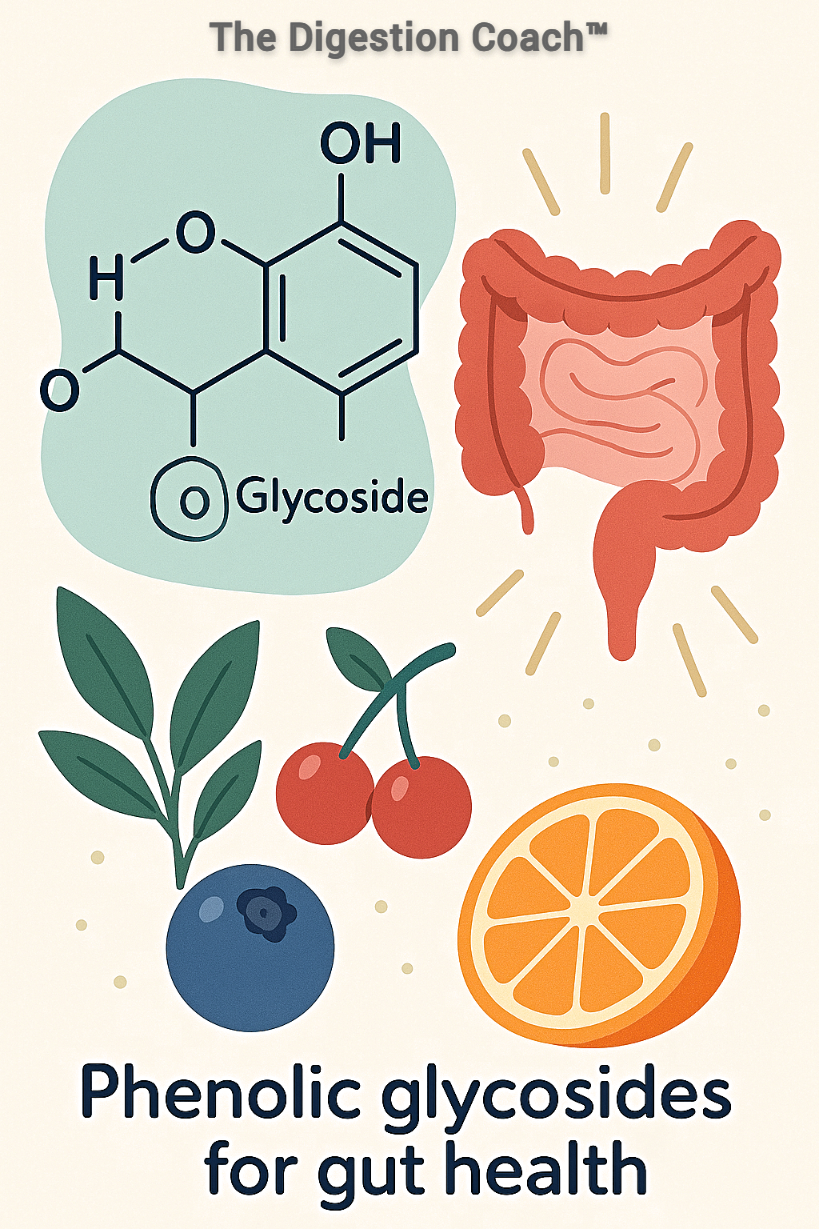Phenolic glycosides for gut health are plant-derived compounds with a phenolic structure linked to a sugar group, offering significant benefits by reducing intestinal inflammation and enhancing resistance to pathogens. These compounds are metabolized by specific gut bacteria into bioactive end products that regulate immune responses and support intestinal homeostasis. Below is an overview of key phenolic glycosides—including salicin from white willow bark—their food sources, metabolizing bacteria, beneficial end products, and a sample diet incorporating these compounds through meals, teas, supplements, and powders.
Salicin
Role in Gut Health: Derived from white willow bark, salicin reduces inflammation and balances immune responses. When metabolized in the gut, it releases saligenin, which regulates intestinal homeostasis and may inhibit pathogen growth.
Food Sources: White willow bark (Salix alba), traditionally consumed as tea or in supplement form.
Metabolizing Species: Bacteroides spp. (e.g., B. ovatus, B. uniformis, B. fragilis): Use β-glucosidases to convert salicin to saligenin.
Beneficial End Products: Saligenin: Modulates inflammation and supports gut barrier function; further oxidized to salicylic acid in the liver, enhancing systemic anti-inflammatory effects.
Arbutin
Role in Gut Health: Arbutin has anti-inflammatory and antimicrobial properties, reducing inflammation and inhibiting pathogens like Escherichia coli.
Food Sources: Bearberries, blueberries, cranberries, pears, wheat.
Metabolizing Species: Bacteroides spp. (e.g., B. uniformis): Hydrolyze arbutin to hydroquinone; Lactobacillus spp. (e.g., L. plantarum): Assist in glycoside breakdown; Bifidobacterium spp. (e.g., B. longum): Contribute to metabolism.
Beneficial End Products: Hydroquinone: Antimicrobial and anti-inflammatory, reducing pathogen colonization.
Phloridzin
Role in Gut Health: Phloridzin offers anti-inflammatory and antioxidant effects, enhancing gut barrier integrity and resisting pathogens like Clostridium perfringens.
Food Sources: Apples (especially peels), apple juice, pears.
Metabolizing Species: Bacteroides spp. (e.g., B. ovatus): Convert phloridzin to phloretin; Lactobacillus spp. (e.g., L. reuteri): Aid in hydrolysis; Eubacterium spp. (e.g., E. ramulus): Produce phenolic acids.
Beneficial End Products: Phloretin: Antimicrobial and anti-inflammatory; 3-(4-Hydroxyphenyl)propionic acid: Antioxidant and gut-supportive.
Verbascoside (Acteoside)
Role in Gut Health: Verbascoside reduces inflammation and combats pathogens like Staphylococcus aureus through its antioxidant and antimicrobial properties.
Food Sources: Olives, olive leaves, verbena, Cistanche spp.
Metabolizing Species: Bacteroides spp. (e.g., B. thetaiotaomicron): Cleave glycosidic bonds; Faecalibacterium prausnitzii: Processes metabolites for anti-inflammatory effects; Lactobacillus spp. (e.g., L. acidophilus): Assist in breakdown.
Beneficial End Products: Caffeic acid: Anti-inflammatory and antioxidant; Hydroxytyrosol: Enhances gut barrier and pathogen resistance.
Rutin
Role in Gut Health: Rutin reduces inflammation and inhibits pathogens like Listeria monocytogenes via its antioxidant and antimicrobial actions.
Food Sources: Buckwheat, citrus fruits (oranges, lemons), apples, asparagus, green tea.
Metabolizing Species: Bacteroides spp. (e.g., B. ovatus): Convert rutin to quercetin; Bifidobacterium spp. (e.g., B. adolescentis): Aid in deglycosylation; Clostridium spp. (e.g., C. orbiscindens): Produce phenolic acids.
Beneficial End Products: Quercetin: Anti-inflammatory and antimicrobial; 3,4-Dihydroxyphenylacetic acid: Antioxidant and gut-supportive.
Ellagitannins (Hydrolyzable to Ellagic Acid)
Role in Gut Health: Ellagitannins reduce inflammation and enhance resistance to pathogens like Helicobacter pylori by modulating the microbiota.
Food Sources: Pomegranates, strawberries, raspberries, blackberries, walnuts, and oak-aged wines.
Metabolizing Species: Gordonibacter urolithinfaciens: Converts ellagic acid to urolithins; Bacteroides spp. (e.g., B. uniformis): Hydrolyze ellagitannins; Akkermansia muciniphila: Supports gut health during metabolism.
Beneficial End Products: Urolithins (e.g., Urolithin A): Anti-inflammatory and antimicrobial; Ellagic acid: Antioxidant and anti-inflammatory.
Sample Diet Incorporating Phenolic Glycosides for Gut Health
Here’s a practical daily plan to integrate phenolic glycosides for gut health through meals, teas, supplements, and powders, emphasizing natural sources and convenient forms.
Breakfast
Meal: Buckwheat porridge with sliced apples (peel on) and a handful of blueberries.
Phenolic Glycosides: Rutin (buckwheat), phloridzin (apples), arbutin (blueberries).
Drink: Green tea.
Phenolic Glycosides: Rutin.
Optional Supplement: White willow bark extract capsule (standardized to 15% salicin, ~100 mg).
Phenolic Glycosides: Salicin.
Mid-Morning Snack
Snack: A small handful of walnuts and dried cranberries.
Phenolic Glycosides: Ellagitannins (walnuts), arbutin (cranberries).
Drink: Pomegranate juice (100% pure, no added sugar).
Phenolic Glycosides: Ellagitannins.
Lunch
Meal: Grilled chicken with steamed asparagus and a side of quinoa topped with olive oil and fresh lemon zest.
Phenolic Glycosides: Rutin (asparagus, lemon), verbascoside (olive oil).
Drink: Verbena tea (made from dried verbena leaves).
Phenolic Glycosides: Verbascoside.
Afternoon Snack
Snack: Sliced pear with a sprinkle of pomegranate powder (available as a supplement).
Phenolic Glycosides: Phloridzin (pear), ellagitannins (pomegranate powder).
Optional Supplement: Rutin powder or capsule (500 mg, mixed into water or a smoothie).
Phenolic Glycosides: Rutin.
Dinner
Meal: Baked salmon drizzled with EVOO and mixed berries (strawberry, raspberry, and blackberries) for dessert.
Phenolic Glycosides: Ellagitannins (berries), verbascoside (olive oil).
Drink: White willow bark tea (1 tsp dried bark steeped in hot water for 10 minutes).
Phenolic Glycosides: Salicin.
Evening Option
Dessert or Drink: Herbal infusion with Cistanche powder (400mg in hot water) or a small glass of oak-aged red wine (in moderation).
Phenolic Glycosides: Verbascoside (Cistanche), ellagitannins (wine).
Practical Tips for Incorporating Phenolic Glycosides for Gut Health
Teas: White willow bark, verbena, and green tea are widely available as loose herbs or tea bags. Steep for 5-10 minutes for optimal extraction.
Supplements: Look for standardized extracts (e.g., white willow bark with 15% salicin, rutin at 500 mg) from reputable brands. Consult a healthcare provider before starting.
Powders: Pomegranate, Cistanche, or rutin powders can be added to smoothies, yogurt, or water for convenience.
Meals: Focus on whole foods like fruits, vegetables, and nuts with peels intact to maximize phenolic glycoside content.
Conclusion
Phenolic glycosides for gut health, such as salicin, arbutin, phloridzin, verbascoside, rutin, and ellagitannins—sourced from white willow bark, berries, apples, olives, and more—support intestinal wellness by reducing inflammation and resisting pathogens. Metabolized by gut bacteria like Bacteroides, Lactobacillus, Bifidobacterium, and Gordonibacter, they yield bioactive compounds (e.g., saligenin, hydroquinone, and urolithins) with anti-inflammatory and antimicrobial effects. This sample diet integrates phenolic glycosides for gut health through accessible foods, teas, supplements, and powders, offering a practical way to enhance intestinal well-being.







